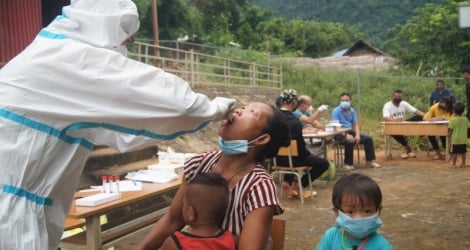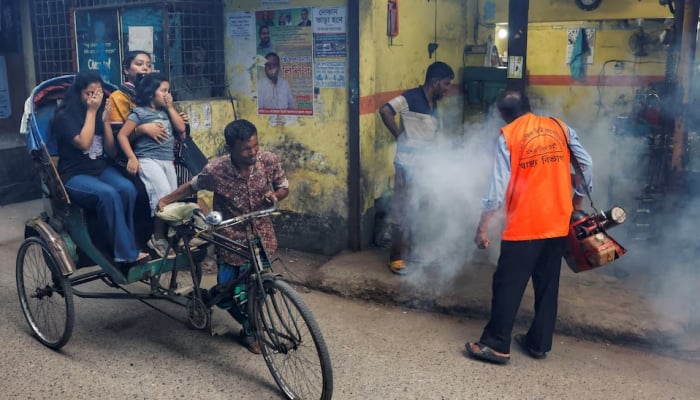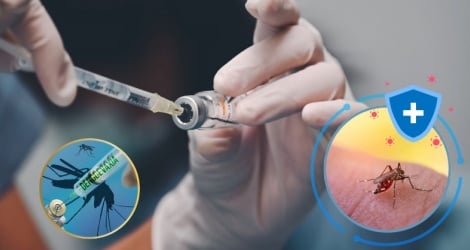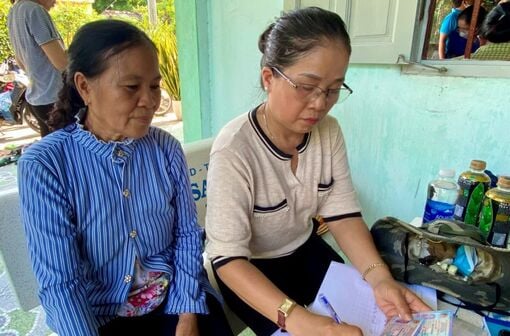Medical news on October 22: In one week, Hanoi had 24 more dengue fever outbreaks
Last week, Hanoi had 403 more cases of dengue fever. The city also recorded 24 more dengue fever outbreaks in 14 districts.
With the current complex and unpredictable weather conditions combined with heavy rain, it creates favorable conditions for the reproduction and development of mosquitoes that transmit dengue fever.
 |
| Dengue fever is caused by four strains of the dengue virus: DEN-1, DEN-2, DEN-3, and DEN-4. All four strains of the virus are capable of causing disease. |
According to the Hanoi Center for Disease Control (CDC), last week (from October 11 to 17), the entire city of Hanoi recorded 403 cases of dengue fever, an increase of 57 cases compared to the previous week.
Patients are distributed in 30 districts, towns and cities. Some districts and towns recorded many patients such as: Dong Da (37 cases); Ba Dinh (31 cases), Ha Dong (31 cases); Thanh Oai (26 cases); Dan Phuong (23 cases)... During the week, the city recorded 24 more dengue fever outbreaks in 14 districts and towns.
Accumulated from the beginning of 2024 to present, the number of dengue fever cases in Hanoi is 4,563 cases, no deaths, down 80.4% compared to the same period in 2023.
The monitoring results of the Hanoi CDC at some outbreak areas last week still recorded insect indexes that exceeded the risk threshold. Therefore, the number of dengue fever cases is forecast to continue to increase in the coming time. The dengue fever epidemic in Hanoi is still complicated.
Currently entering the peak month of dengue fever season, Deputy Director of the Department of Preventive Medicine (Ministry of Health) Nguyen Luong Tam said that the capital's health sector needs to strengthen coordination with relevant units to synchronously deploy epidemic prevention measures, focusing on eliminating mosquito larvae.
Along with that, the city needs to mobilize the participation of sectors, levels, and socio-political organizations in preventing and fighting dengue fever.
This week, in areas where insect monitoring results exceed the risk threshold, the Hanoi Department of Health has proposed organizing environmental sanitation campaigns, mosquito larvae eradication campaigns, and chemical spraying campaigns to kill adult mosquitoes.
In addition, units need to inspect and monitor disease prevention and control work in areas with many cases, complicated outbreaks, and high-risk areas, in order to assess the situation and thereby deploy appropriate and timely measures.
Many people think that mosquitoes that transmit dengue fever only live in stagnant public ponds, sewers, etc. However, Aedes mosquitoes live in places with clear water that has been left for a long time, such as aquariums, flower vases, rockeries, rainwater stagnant in broken bowls in home gardens, alleys, terraces, construction sites, etc. Therefore, it is necessary to remove stagnant water containers that are places for Aedes mosquitoes to breed and develop.
It is necessary to clean the house, turn over all mosquito hiding places to kill larvae, then spray insecticide to kill adult mosquitoes.
To kill mosquitoes more effectively, spray in the morning, because dengue mosquitoes are most active during the day, most active in the early morning hours and before sunset. It should be noted that insecticide sprays are effective for 6 months from the time of spraying.
Many people believe that once they have had dengue fever, they will not get it again. This is not necessarily true. Dengue fever is caused by four strains of the Dengue virus: DEN-1, DEN-2, DEN-3, and DEN-4. All four strains of the virus can cause the disease.
Therefore, if a person has had dengue fever, during the illness the body can create antibodies. However, the immunity created is only specific to each individual strain. The patient may not be reinfected with the old strain of the virus, but can still be infected with the new strain, so dengue fever can recur.
Regarding treatment, many people think that when having dengue fever, you should only drink electrolytes, not coconut water because it does not have a rehydration effect and it is difficult to detect complications.
This is completely wrong, in dengue fever, high fever for many consecutive days will cause the patient to become dehydrated and lose fluids. The simplest way to compensate for fluid loss is to give the patient Oresol.
However, many patients have difficulty drinking Oresol. This can be replaced by drinking coconut water, orange juice, grapefruit juice, lemon juice to compensate for the lost fluid. Moreover, the above fruits contain many minerals and vitamin C, helping to strengthen the immune system and increase the strength of blood vessels.
Beware of tick fever
Recently, at the Infectious Disease Resuscitation Department, 108 Central Military Hospital received and successfully treated 2 patients with Scrub typhus with multiple organ failure complications.
The patient was admitted to the hospital with symptoms of prolonged fever, multiple organ damage: respiratory failure, circulatory failure, liver and kidney damage, bone marrow suppression. Both cases were actively treated by lower-level facilities but the microbial cause of the disease was not found, so the treatment was not responsive.
The patients were transferred to the Infectious Diseases Department in a state of multiple organ failure (respiratory failure, circulatory failure, liver failure). Doctors examined and discovered typical scrub typhus ulcers, and treated them with specific antibiotics (Doxycycline) and supportive treatment for organ failure. After treatment, the patients responded well, their fever subsided, their organs gradually recovered, and they were discharged after 2 weeks of treatment.
Signs that may suggest that the patient has scrub typhus: The patient lives or travels to forested or mountainous areas with dense vegetation, which are places where mite larvae live.
Long-term fever is common, lasting 10 to 14 days, without a clear site of infection.
There is peripheral lymphadenopathy, especially in moist areas such as the armpits and groin. Along with that, near the swollen lymph nodes, there is a typical ulcer caused by scabies (a round or oval ulcer, smooth, concave surface, black crust, painless, not itchy), however, there are many cases where the ulcer is not detected.
According to medical experts, some measures to prevent tick fever: Limit activities in the mountains and forests when not necessary.
If you are forced to live and work in such high-risk conditions, you need to take measures to protect your body from being bitten by mite larvae: Wear clothes that cover your body, apply insecticide to clothes and bedding, spray insecticide into the air or apply insect repellent to your skin.
Scrub typhus is a disease caused by the agent Rickettsia tsutsugamushi, transmitted to humans when bitten by mite larvae. The disease has typical clinical manifestations of fever, painful swollen lymph nodes (usually seen in the lymph nodes around the bite), and skin rash.
Common complications include myocarditis, septic shock, and multiple organ damage leading to death. However, the disease can be treated and recovered well if diagnosed and treated promptly.
How dangerous are foreign bodies in the digestive tract?
On October 19, 2024, the Department of Digestive Endoscopy, 108 Central Military Hospital received a 38-year-old male patient transferred from Bac Quang District Hospital, Ha Giang.
For the past two weeks, the patient has had abdominal pain and indigestion. A gastroscopy at the previous facility showed a foreign body mass of food residue, but no intervention was made to remove it.
The patient came to the department with severe abdominal pain and vomiting. The endoscopy showed that the foreign body was a thick yellow food mass, black in color, in the stomach cavity, restricting circulation. Immediately, the team proceeded to cut the food mass into small pieces using special tools, "tearing" the foreign body.
Fortunately, the patient was detected early so the foreign object did not cause complications such as ulcers or gastric bleeding. After the intervention, the patient was stable and was instructed to follow up at home.
Medical history revealed that the patient had recently eaten large amounts of homegrown wild yam with honey for a long period of time, especially when hungry.
The yam is one of the fruits rich in fiber, consuming large amounts of foods rich in fiber and tannin such as persimmon, guava, fig, bamboo shoots can be one of the risks of forming food residue during digestion.
In particular, if eaten when hungry, the stomach is still empty, they easily precipitate, causing the plant fibers to stick together, forming a solid mass that gradually grows larger over time, causing symptoms for the patient such as bloating, indigestion, abdominal pain, nausea and vomiting, gastrointestinal bleeding due to ulcers at the site of friction and pressure, intestinal obstruction, etc.
Therefore, people should limit the use of foods containing a lot of fiber and tannin, especially should not eat when hungry, eat slowly, chew thoroughly and drink plenty of water.
If you experience abdominal pain or nausea after accidentally swallowing large pieces of food or eating sticky substances, you should go to a reputable medical facility to detect foreign objects early and avoid unwanted complications.


![[Photo] Tan Son Nhat Terminal T3 - key project completed ahead of schedule](https://vstatic.vietnam.vn/vietnam/resource/IMAGE/2025/4/15/85f0ae82199548e5a30d478733f4d783)

![[Photo] Prime Minister Pham Minh Chinh works with state-owned enterprises on digital transformation and promoting growth](https://vstatic.vietnam.vn/vietnam/resource/IMAGE/2025/4/15/f55bfb8a7db84af89332844c37778476)
![[Photo] Vietnamese and Chinese leaders attend the People's Friendship Meeting between the two countries](https://vstatic.vietnam.vn/vietnam/resource/IMAGE/2025/4/15/7d45d6c170034d52be046fa86b3d1d62)

![[Photo] Celebrating the 70th Anniversary of Nhan Dan Newspaper Printing House](https://vstatic.vietnam.vn/vietnam/resource/IMAGE/2025/4/15/a7a2e257814e4ce3b6281bd5ad2996b8)

























![[Photo] Reception to welcome General Secretary and President of China Xi Jinping](https://vstatic.vietnam.vn/vietnam/resource/IMAGE/2025/4/15/ef636fe84ae24df48dcc734ac3692867)





























































Comment (0)